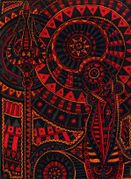Difference between revisions of "Talk:Zohal"
| Line 15: | Line 15: | ||
</gallery> | </gallery> | ||
| − | style ideas for make up can come from themes in the story and art people have created of Eshu and Orishas. Also, stylistic elements can be taken from [https://en.wikipedia.org/wiki/Aperiodic_tiling aperiodic tilings | + | style ideas for make up can come from themes in the story and art people have created of Eshu and Orishas. Also, stylistic elements can be taken from [https://en.wikipedia.org/wiki/Aperiodic_tiling aperiodic tilings] as well as traditional Islamic mosaics. dazzle art. |
Cosentino, Donald. “Who Is That Fellow in the Many-Colored Cap? Transformations of Eshu in Old and New World Mythologies.” The Journal of American Folklore, vol. 100, no. 397, 1987, pp. 261–275. JSTOR, JSTOR, www.jstor.org/stable/540323. | Cosentino, Donald. “Who Is That Fellow in the Many-Colored Cap? Transformations of Eshu in Old and New World Mythologies.” The Journal of American Folklore, vol. 100, no. 397, 1987, pp. 261–275. JSTOR, JSTOR, www.jstor.org/stable/540323. | ||
Revision as of 09:18, 20 December 2018
Useful links
http://crookedtimber.org/2018/12/01/saturday-art-blogging-patterns-in-islamic-art/
https://patterninislamicart.com/
https://en.wikipedia.org/wiki/Kuchipudi
- Eshu art
Exu by Henrique Vieira
style ideas for make up can come from themes in the story and art people have created of Eshu and Orishas. Also, stylistic elements can be taken from aperiodic tilings as well as traditional Islamic mosaics. dazzle art.
Cosentino, Donald. “Who Is That Fellow in the Many-Colored Cap? Transformations of Eshu in Old and New World Mythologies.” The Journal of American Folklore, vol. 100, no. 397, 1987, pp. 261–275. JSTOR, JSTOR, www.jstor.org/stable/540323.
"Eshu's Cap: One day Eshu walked between the farms of two friends wearing a multicolored cap (variously described as red and white; red, white and blue; or red, white, green, and black). He also put his pipe at the nape of his neck and hung his staff over his back. As he passed back and forth, the friends quarreled about his appearance and the direction he was walking, until they came to blows. Later, when the disputants brought him to court, Eshu confessed to the trick, boasting that "sowing dissension is my great delight." Then he fled, starting a fire along the way and mixing up all the possessions of fleeing townsfolk (Pelton 1980:141). Thus testing and exposing friendships, creating and destroying wealth, Eshu exits laughing."
